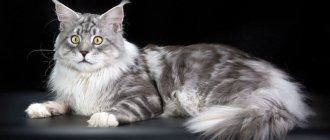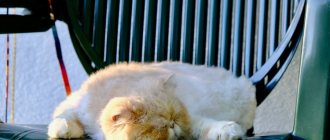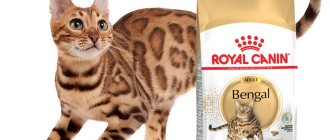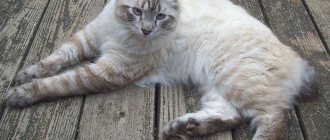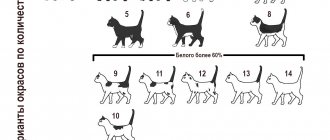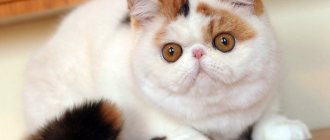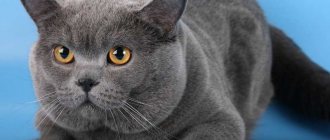Albino animals often attract human attention. Their snow-white fur makes them stand out among their other brethren. This gene is also found among cats. However, not all white cats are albinos, and not all albinos are completely white. Let's look at how albinism manifests itself in cats, what breeds have a genetic predisposition to albinism, and what are the health and behavioral characteristics of albino cats.
How to communicate with such a cat?
Of course, keeping deaf cats has its own characteristics. Owners will have to get used to the fact that much of the behavior of such animals will be unusual for them. They will never be able to successfully hunt birds. They won’t make hunters, because you can’t explain to a cat that a bird hears when someone is creeping up on it. This means you need to sneak up on her as quietly as possible.
Deafness in cats can bring them a lot of trouble, because they have to live in a world of hearing people and animals. Therefore, they need constant supervision. They do not need to be allowed outside alone, because they will not even hear a dog or other animal approaching them, which can greatly frighten them. It is even more dangerous to let such cats out onto the street where cars drive. Without hearing the car signal, the cat will not have time to jump away in time and may fall under the wheels.
Despite their peculiarity, white cats have a wonderful cat character. Most of them:
- gentle and affectionate;
- love to communicate (although their communication is of a slightly different nature);
- sensitive;
- They quickly get used to their owner and are devoted to him (although they will play with other family members with no less pleasure).
But their excessive sensitivity may cause them to become afraid of strangers.
Keeping white cats includes grooming their coat, as stains and dirt are especially noticeable on a white background. You will have to accustom the animal to taking baths. Let him know that this is necessary. After this procedure, be sure to treat the cat to something tasty that he especially loves.
In nature, such animals are very noticeable, which sometimes poses a threat to their life. Don't let cats walk alone, they simply cannot survive without people. Especially if the animal is deaf. If you see an “ownerless” white cat on the street, take it in and try to find the owner. She must have gotten lost.
If you understand that you can solve all these problems, feel free to make such a friend.
Character
In order to understand such an animal, it is enough to imagine how those born with a defect survive in nature. But they survive with great difficulty, and most often do not survive at all. Natural selection in the wild occurs mercilessly, and no one will mess with someone who does not meet the parameters and requirements of the pack.
A white predator will not be able to go hunting and at the same time remain unnoticed by its prey . This means that there is a great certainty that he will have to starve. If an animal that is usually hunted by predators was born snow-white, then it has a greater chance of becoming prey than its relatives. It stands out too much and is noticeable over long distances.
Hence the loss and feeling of inferiority. Animals rejected by their kind are more attached to those who care for them and keep them company, namely people. Now you understand why such unusual kittens born from domestic cats are not recognized as marriages among people and are not destroyed.
They are welcomed by humans as the most affectionate and loyal of cats. And besides, we love the color white. We associate it with purity, evokes tenderness and a desire to show care. But what are we dooming cats to by allowing them to live?
Breeds
British
A beauty with a soft velvety coat. The cat's body is strong, muscular, with powerful paws. The face has the characteristic “smile” of the Cheshire cat. The cat's ears are erect and rounded, so do not confuse it with the Scottish Fold cat.
These cats do not require special attention. The exception is daily brushing. This is more pleasant to do than sweeping balls of wool out of your apartment every day. Despite the thick undercoat, it is necessary to protect your pet from drafts.
The character of the animal is special. It loves its owner dearly, but can endure separation for a long time without giving the appearance of being sad. Does not favor children and other animals in the house, but does not conflict with them either. He treats strangers coldly, but will never rush to scratch or bite.
If a cat does not want to communicate, calling it and catching it by forcefully holding it is useless. A Briton can allow himself to be caressed only when he wants to. You can scold and punish a cat only at the moment of committing a “dirty deed”, otherwise it will not understand why they are so unmerciful to it. It is absolutely forbidden to beat purebred British women: the animal is vindictive and will definitely come up with revenge for you.
Maine Coon
Maine Coons are special cats. They are the largest and longest in the world, have fluffy long hair and a very thick undercoat that protects them from severe frosts. Maine Coons have especially good fluffy pants on their hind legs and a collar. The pets' tail is simply gorgeous - like a white fan. The cat's body is muscular, strong, with long powerful legs.
By nature, Maine Coons are very good-natured. They adore children and other animals living in the house, and are distinguished by canine fidelity and devotion to their owners. Cats are active, rush around the apartment with toys, climb onto all the tall cabinets.
Breeders of this breed say that the Maine Coon needs a “hole” and a “mountain”. This means that the cat must have his own house where he will relax, and a sports complex in the form of a scratching post with turrets of various heights on which he will jump.
Turkish Angora
Blondes of this breed look very elegant. They have a slender body with well-developed muscles, a graceful long neck and a wedge-shaped head proportional to the body. The fluffy tail of extraordinary beauty resembles the feather of a snow-white fairytale bird.
The animals are smart and easy-going, love solitude and peace, are not particularly playful and are not too “talkative”. Suitable for those people who lead a measured lifestyle, without fuss and haste. Angoras do not require complex care. They carefully clean up the mess, not allowing the wool to roll into tangles.
Foreign white
This is the only breed of short-haired cat that has only one color - white. Slender, long-legged, well-built cats are small in size. The maximum weight of the animal is about 5 kg. The fur coat can be boiling white, and the muzzle has a color like that of a Siamese cat - the progenitor of this breed.
Foreign Whites are cheerful, kind and funny animals. Full of tireless energy, they are ready to play all day long and, like a devoted dog, run after you around the house. The best place to rest them is on your knees, neck and shoulders. They love to have a heart-to-heart talk, especially if they have something to complain about.
Persian
Representatives of this breed are the fluffiest. The head, body, tail and paws are all covered with soft hair, the length of which can be almost 12 cm. The body of Persian cats is squat, small, and the legs are short. The weight of an average cat reaches 7 kg, and because of its fluffy fur coat, it looks like 15 kg.
Snow-white Persian beauties are trusting, inquisitive and calm. Vanity and endless noise are not for them. Persians prefer to spend time on your lap and are ready to relax on them for hours. Cats treat guests and children with indifference and do not fight with other animals living in the house.
Devon Rex
These are amazing cats with a long elongated body, graceful high paws and cute soft curls on the body. You want to grab this charming Devon in your arms and endlessly cherish him, stroking his snow-white curls. Devons are cheerful, good-natured, sociable and talkative. Their angelic look fully matches their beautiful character.
The animals are endowed with high intelligence: they carry out simple commands from their owner and are even able to fetch slippers. They are loyal and good friends to everyone who is close to them; they cannot stand loneliness and suffer when separated from their family.
Turkish Angora
Another cat breed with different eye colors is the Turkish Angora. This animal is small in size, has small bones, and has a long body with round ribs. The weight of the animal is on average 5 kg. Angoras quite often have representatives of the breed with a similar phenomenon. The head has long erect ears. The body of the animal may be covered with fur
:
- cream;
- white;
- black;
- blue;
- even red.
Felinologists say that this particular breed is the most common white-colored individual with different eyes. These kittens were first bred in Angora, in Byzantium, from which they got their name. Already in the sixteenth century, the breed was brought to continental Europe.
To ensure that Angora does not get sick, is active and mobile, it is recommended to include food with biological additives in her food. The animal must be brushed regularly. She also urgently needs her ears cleaned and her nails trimmed.
Angoras have an active temperament. They simply love to be the center of attention, are excellent at training, and love physical activity. So smart that they can learn simple tricks. Photos of such an animal will decorate any photo album.
Cat breeds with different eyes have always attracted special attention. Some consider them mystical creatures, while others love their pets without attaching much importance to the color of their eyes, just for who they are.
Different eye colors are usually found in completely or partially white cats, but there are colored and black animals with heterochromia. This feature is a consequence of a lack or excess of melanin pigment, which also affects the color of the animal’s coat and skin.
Heterochromia occurs in humans, but is much more common in cats. Moreover, one eye is blue, and the other can be orange, yellow or green. This feature often indicates existing health problems, for example, deafness, but this is not the rule.
Albino animals in the wild
This kind of gene anomaly significantly complicates the life of its carrier, since the lack of camouflage coloring makes the process of survival in nature quite difficult. For example, how can you hunt and get food, having a beautiful snow-white coat, which makes the owner stand out from the pack of natural colors? Moreover, it is not an easy task to hide from predators.
It's sad that albino animals are very poorly valued among their relatives when it comes to lovemaking and procreation.
When selecting a partner, the female pays attention to the bright, rich coloring of the male, as it guarantees that the offspring will be protected in terms of camouflage in nature and healthy. Therefore, a white tiger or a peacock with pink eyes has absolutely nothing to count on
It often happens that such individuals have no offspring at all.
Problems with food, finding a “other half” and easy accessibility to agile predators are reducing the albino population. In most cases, albino animals have poor vitality, as they are extremely sensitive to sunlight and have problems with hearing and vision. In addition to not being accepted into the pack, such animals are at high risk of skin cancer.
Throughout their lives, albinos have reduced immunity, so their body is susceptible to various infections. It should be noted that, with the exception of their amazing color, albinos are no different from their counterparts.
People, unlike their fellow albinos, go crazy over beautiful and unusual animals with the rarest colors. Many beliefs and secrets shroud snow-white individuals. Since ancient times in Siberia, albinos were called “princelings” and there were various superstitions about them. For example, commercial hunters believed that hunting an animal devoid of melanin would certainly bring success and happiness. There is a legend about a Prairie horse with a snow-white color, who was the ruler of huge herds of mustangs.
In Thailand, only royalty had the right to own white tigers or elephants. In India, Raja Mohan, having one white tiger cub, bred a whole line of albino tigers, devoid of natural natural pigment.
It is interesting that if a mixture of albinos occurs in nature, then a whole generation of albino animals is born and a new species is created - scientists have noticed this fact in the trumpeter pigeon and ferrets.
Caring for white blue-eyed pets
Some owners are afraid to take a white cat into the house because of its brand of fur coat. There are indeed difficulties in caring for, but not so global as to give up on a small white lump. Any coat needs care, but light hair is especially important. After all, even a small spot can turn a luxurious beauty into an ordinary mess.
Some tips for caring for your white pet:
- A white cat will need to be washed more often than darker-colored animals. To take water procedures, you should purchase special white coat care products. If your cat absolutely does not like to be washed, you can buy dry shampoo.
- After taking a bath, the cat should be thoroughly dried with a hairdryer. Dirt sticks to dry wool much less.
- To prevent tangles from forming on the fur, furry animals should be brushed daily.
- If the house is dirty, this will immediately affect the appearance of the pet. In the area where a white cat lives, wet cleaning will have to be done more often.
- If an animal has hearing problems, it should be closely monitored. To avoid trouble, deaf cats are not allowed to leave their homes. If the cat still wants to go outside, you will have to get a harness.
- White cats are more susceptible to ultraviolet rays than their relatives. It is better to protect your pet from frequent exposure to the sun.
- Cats with white fur often suffer from allergies. Therefore, you need to carefully monitor the diet of the blue-eyed blonde.
Since we had a white cat in our house, I can say a few things about caring for her. A cat is a mobile animal; it climbs into all hard-to-reach places and collects dust and dirt there. This is especially noticeable on a white fur coat. Therefore, cleaning had to be done almost every day. The most easily soiled areas of white animals are the muzzle, neck area and groin area. But snow whites are very clean and take excellent care of their appearance. If something happened, we bathed the animal and then dried it with a hairdryer. But, in my opinion, any cat needs to take water treatments from time to time, regardless of color. And we didn’t have any special problems with nutrition and separate care.
White cats with blue eyes have incredible magnetism and attractiveness. The captivating appearance of these beauties is combined with a flexible mind, gentle disposition and friendly character. The blue-eyed blonde will become not only a decoration of the house, but also a reliable, devoted friend to her owner.
How to distinguish an albino from a white cat
If a meowing pet has blue, orange or green eyes, then it is not an albino. True albino cats have pink or pale bluish-pink eyes and are very sensitive to light. When light hits the eyes, they appear pink-red because blood vessels become visible. It should be taken into account that with partial albinism, animals have pale blue eyes, which causes difficulties in determining the mutation by external signs.
Albinos are completely absent or have small amounts of pigment cells (melanocytes), and white individuals have melanocytes, but are masked by the mutant W gene. Such animals are characterized by bright blue, blue eyes, heterochromia is sometimes observed, and they are more common than individuals with other color suffer from deafness.
There are 5 alleles for albinism: blue-eyed (ca*), pink-eyed (c), Burmese (cb), Siamese (Cs), solid (C, dominant over all alleles).
*the first symbol is a dominant gene, the second is a recessive gene.
It is noteworthy that the Siamese depends on body temperature. The colder the area of the body, the darker it is. Among the Siamese, white, blue-eyed individuals can be born, which are usually called foreign whites (foreign white). Individuals with partial albinism have light blue eyes. The tapetum glows red rather than green in low light.
What determines the white-blue-eyed combination?
Snow-white fur in cats is also not a very common color in nature.
There are three main reasons why a cat may have blue eyes:
- Gene dominance. The gene that provides the animal with a snow-white color often also becomes the cause of the cornflower blue color of the iris. The chance of an unusual iris color is the same for pure white pets and for those in which white predominates in the overall color. However, gene activity usually reduces hearing acuity, sometimes to the point of complete deafness.
- Genetic code of albinos. In cats, albinism manifests itself in the form of white fur combined with aquamarine eyes.
- The color of the fur on the face. Cats that have white spots on their faces around their eyes are more likely to have blue irises.
For the same reasons, cats have eyes of different colors. Kittens are always born with gray or blue eyes, which change color as the pet grows older.
Albino cats are sensitive to light
The lack of pigmentation in true albino cats is due to their inability to produce melanin. Melanin does more than contribute to skin tone. In cats, as well as other creatures including humans, melanin has a number of functions. For cats, melanin gives color to the skin, coat and eyes. In the eyes alone, it also helps in depth perception. On a more holistic level, it helps in the body's ability to fight infection and disease.
Most importantly, melanin's role in giving color to the eyes, skin and coat, and the complete absence of albino cats means that they are very sensitive to light. Albino cats may not have other health-related problems, but direct sunlight is harmful to their vision and potentially breaks down their skin with long-term exposure. Owners of Albino cats should be very careful about the cat's exposure to direct sunlight.
Why is the iris blue and the fur white?
A special pigment, melanocyte, or rather its quantity, is responsible for everything. The less of this “ingredient” in a cat’s iris, the more likely it is to be blue or cyan. A high content of the substance will color the iris brown or green.
Genetics played a big role in the phenomenon, but we will not delve into the jungle of the genetic code, but simply say: that the “blue-eyed” gene is paired with the gene for white coat coloring (W).
The latter, during intrauterine development, negatively affects the migration of special cells - melanoblasts - to the skin and organs of vision. In some cases, the substances do not have time to reach the hair follicles and iris in time, as a result of which the fur is not colored, and the eyes lack the very pigment responsible for color.
This is why snow-white cats, as well as animals with white spots on their coats, are most often born with blue eyes.
Deaf or not?
There is a claim that blue-eyed cats are deaf. Snow-white pets, indeed, are found to be completely or partially deaf, since the W gene, which dominates the other genes of the animal, has pleiotropic abilities - it directly affects the color of the coat, iris and the formation of hearing organs. This does not mean that absolutely all white cats with blue eyes will not hear you. Green-eyed, yellow-eyed and heterochromic (with different eye colors) kittens may also suffer from a similar pathology.
If you come across a white deaf cat, do not despair. Animals are distinguished by their kindness and gentle character. Active and sociable, such cats willingly play, hunt mice and rush around the apartment like ordinary cats. You can determine that an animal is deaf very simply:
- turn on the vacuum cleaner next to the kitten: a deaf animal does not react to loud sounds;
- the cat is very “loud”: loudly sneaks behind the bird, digs in the tray, meows.
The behavior of an animal largely depends on its character and how correctly you raise it.
Such a cat does not require special living conditions, but when communicating with a deaf animal, it is important to remember the following nuances:
carefully open and close all doors, otherwise you may injure the cat - she does not hear your actions; keep the windows closed: a deaf cat has no sense of fear and can jump down; do not let your cat go outside alone, it is dangerous; move around the house carefully, watch your step so as not to step on the animal; communicate with your pet using conventional gestures.
Cats suffering from deafness become very attached to their owner. They are completely dependent on people and need constant help.
Life of a street and indoor cat
Life expectancy is affected by habitat. Well-groomed and caressed domestic cats live much longer than their street counterparts. The latter have to survive, get food, and hide from the cold in winter. In the cold, death from hypothermia overtakes animals quite quickly.
Kittens born in the basement or on the street die in the first months of life in 90% of cases. The reason for this is weakened immunity, lack of heat and viral diseases. Only the strongest survive, but they have yet to prove their strength in street fights. It is not surprising that they have a short life span - few live up to 7 years, and a 10-year-old street cat will be considered a long-liver.
Animals that end up outside from home find themselves in even worse conditions. Most often, the owners refuse them, indifferently throwing them away like an unnecessary rag. The chances of living at least a year on the street for cats unadapted to such conditions are negligible.
The life of a pet is a different matter. There is good food in the bowl, a warm bed in the room. Vitamins and vaccinations protect against diseases; at the slightest deviation, a caring owner will take all measures to restore the pet’s health.
Dream Interpretation - Eyes
The appearance of the eyes, the quality of vision are signs of the dreamer’s state of mind, the intensity of the dreamer’s spiritual life, their health, illness. The dreamer's own organs of love, his sex, potency. Having good vision and moving your eyes quickly is a blessing, happiness, health. It’s hard to see, it’s hard to open your eyes. They slowly toss and turn - loss, poverty, harm from sexual exhaustion. Being nearsighted is a nuisance. Feeling pain in the eyes, sand in them or something bothering you is an unpleasant self-knowledge, a bad conscience. Having a thorn is a deception. You will have to take a lot of care for adult children; they will not go out into public life soon. Losing one eye means complicated affairs, useless work, misfortunes with children. The eye leaks in a dream - pangs of conscience. Going blind in a dream means trouble, betrayal, death of loved ones: children or sister. Rubbing your eyes is a sign of masturbation. Seeing in the mirror that you have big beautiful eyes is happiness (happiness is in children). That you have dull, sore eyes means misfortune (anxiety about children). Seeing yourself in the mirror with colorless or white eyes means realizing the soullessness of your behavior. With eyes bulging out of their sockets - petrification of the soul, callousness. Seeing yourself in a mirror with holes instead of eyes means loyalty to intuition, deep insight, clairvoyance. With burning eyes - you feel dangerous, demonic forces within yourself. Seeing your eyes fall out means a wedding, children will begin an independent life. Taking out and examining your eyes means a feeling of the falsity of your perceptions, a wrong idea of the world. See your children from a new perspective, your intimate life will become the subject of conversation. Having a third eye in a dream means giving birth to a child. For a woman: pregnancy. There is a danger of destroying what you have created with your labors. Use the light from your eyes to illuminate your path - to begin to perceive the world in a new way. Seeing as if some creature is chasing you and trying to eat your eyes means experiencing inconvenience and trouble from other people’s secrets. A warning against the dangerous development of spiritual powers, dangerous spiritual immaturity. Seeing the human eye on a table, in a bowl, glass, etc. - shameful details of your life will be revealed, and you will feel fear of divine justice. Seeing a bunch of human eyes are precious stones. Seeing eyes with eyesores means your enemies are closely watching you. Seeing someone's evil gaze is a bad dream, foreshadowing a dangerous collapse of plans, deception, most likely occurring from relatives. To see only someone's eyes in the darkness - the hard work of your conscience, hidden from you, will yield unexpected results; someone is watching you. To see dull ghost eyes in daylight without a body is an unpleasant, painful split personality to experience. Seeing a brightly sparkling eye in the clouds in the sky is a symbol of authority that should be obeyed. To gouge out someone's eyes is to scare away and turn people against you, and you will suffer severely from jealousy.
Martyrs of selection
Despite the rejection of their relatives, people really like white individuals. The desire to have something original, unusual is so characteristic of human nature. There have long been legends about white animals. Only kings could have albino elephants in Thailand. And the Indian Raja Mohan was specially involved in breeding snow-white tigers. If in the wild a gene mutation is a death sentence for an individual, in human society it began to be cultivated.
Together with rabbits, nutria and minks, species of cats appeared in which this defect, causing a white color, was fixed from generation to generation. In the wild, the chance of two albinos meeting is minimal. And the opportunity to give birth to offspring is small for such an individual. A recessive gene may or may not appear in subsequent generations. But selection, carried out not by nature, but by man, has brought out a whole series of sufferers who carry serious illnesses, but delight their owners with a beautiful snow-white fur coat.
Color options
All snow-white Bengals are very similar and beautiful in their own way, however, they differ in genotype.
Links
These beauties were born as a result of crossing Bengal breeds with Siamese cat breeds. Their body is completely white with small beige markings called points. The difference between the background and the pictures is almost invisible, however? the spots are quite pronounced.
This cat breed has blue eyes that turn ruby when flashed. Lynx Point babies are born almost white and remain that way for a long time. Only after 75 days can faint manifestations of the spots be seen, however, only after a year the pattern will be quite noticeable. Lynxes not only have a brown tint to the tip of their tail and nose, but also the pads of their paws and the rims of their eyes.
Sepia
This type of cat appeared as a result of crossing Bengals and Burmese. Sepia are considered the darkest representatives among snow Bengals. Their body is not completely white, rather creamy. The fur is “decorated” with bright cinnamon-colored spots. In those sepia that have a solid color, the difference between the body and the spots is completely indistinguishable. Just like the Lynx, the tip of the tail and other parts of the body have a brown tint.
Minky
This type of cat has a Tonkinese color, which is also called “mink”. Many people call this type of animal marbled. It appeared as a result of crossing Siamese and Burmese breeds. At birth, kittens already have patterns on their bodies. The body is cream colored and has brown and dark orange markings. In all other respects, they are similar to other subspecies of Bengal cats. Their eyes can be blue, green, or with a golden tint.
Albino mating
Due to various health problems, mating albinos is a very dubious idea. However, breeders often ignore possible diseases of future offspring and cross albinos with representatives of different breeds.
A mutation at the gene level is inherited only if both parents are carriers of the W gene. However, due to the rarity of such individuals, matings occur infrequently. Breeders do not recommend breeding two albinos: there is a high probability of offspring being born with numerous disabilities (hearing loss, vision loss, disorders of the musculoskeletal system, etc.).
Mating among albinos is not encouraged, but it is possible to breed an albino with ordinary cats
Mating with an ordinary cat is quite possible, since in this case, due to the recessiveness of the albinism gene, normal kittens with some color are born.
Deafness of white cats
Often among white cats there are deaf representatives. The phenomenon of deafness in white cats is explained by the same genetics. In the cat's inner ear, sound sensations are created thanks to a special fluid secreted by cells. This fluid is called endolymph. Cells that lack pigment cannot function normally, they do not secrete enough endolymph, so the cat has hearing problems. With this mutation, the organ of Corti degenerates within a few days at birth.
The formation of the hearing organs in kittens begins from 6 to 14 days. Transport of melanoblasts occurs in the first 5 days, so kittens even have an idea of what sound is. The lack of hearing in such cats is more than compensated for by other sensations. White fluffies do not feel any discomfort or inconvenience.
It is worth noting that deafness in white cats can be either complete or partial. This is very easy to recognize. Cats with blue eyes are almost guaranteed to be deaf. Blue eyes indicate that the retina has not received enough pigmented cells capable of secreting endolymph in sufficient quantities. Cats with different eyes will be deaf in the ear that is located on the side of the blue eye.
How to determine if a kitten can hear?
If you have a white pet in your house and you doubt its hearing, you can check it as follows - stand behind the kitten, pick up a piece of paper and remember it a little so that it makes a rustling sound. See how the kitten reacts - which ear it moves, which side it turns.
If the baby does not respond to the sound, do not be upset. Cats with hearing problems are no different from their hearing relatives; many owners live with hearing-impaired cats for several years and don’t even notice it. However, do not forget that deaf animals require special care and attention.
Maintenance and care
Albino cats are very vulnerable to various diseases, and they also have fragile health. That is why such animals need more careful care. When purchasing an albino pet, the owner must be prepared for the fact that such a cat will have to pay much more attention than its colored counterparts.
Due to their fragile health, albino cats should only be kept indoors. Walking on the street is contraindicated for them. On the one hand, they are vulnerable to various infections, as well as drafts. On the other hand, sensitive skin gets sunburned easily. In addition, walks can be a source of stress for rather timid albinos.
It is advisable for the cat to have its own place at home. You can buy a special house in which your pet can hide and feel protected. Albinos really need the attention of their owner. If the owner is at work all day, the animal may become very bored and even stressed. This is especially true for cats with special needs - deaf and blind, who need much more attention.
Dream Interpretation - Eyes
If anyone sees an eye on his hand, he will receive a certain amount of hard cash. If a poor person sees himself blind in a dream, he will be freed from the burdens of need. And if an important person, while traveling, sees himself blind in a dream, he should abandon that trip. If he continues on his way, he will not return from this journey back
If a person on a journey sees one extra eye in his dream, he will get lost, and if a person staying in one place sees such a dream, he should take great precautions to protect his property. If someone sees in a dream that he is rubbing his eyes with antimony, then he will work to educate himself in the truths of faith and will exalt himself in the eyes of people; if he sees antimony on his hand, he will receive property
What is albinism and how does it manifest?
To begin with, it is worth noting that the color white does not exist in nature - there is only the absence of black. This absence can be complete or partial; it is due to the presence of the coloring pigment - melanin. The concentration of this substance determines not only the specific color, but also its intensity.
Full
The enzyme tyrosinase is responsible for the production of melanin. If it is not observed in the body, then this type of albinism is called complete. This variety occurs only in 1 in 10 thousand cases and is a real rarity.
Partial
If the enzyme is still present, but in very small quantities, then the melanin it produces is simply not capable of coloring all available areas of the body. In this case, most of the body remains white, and its individual parts are painted in other colors. This type of albinism is called partial.
Suppression by a separate gene
The production of tyrosinase is suppressed by a mutation in the TYR gene. The final color of the animal depends on the form of the anomaly, that is, the allele:
solid
– allele C;
Burmese
– allele cb;
Siamese color point
– cs allele;
complete albinism
– allele c.
The first type is always dominant, and the last is always recessive. This means that the combination with the C allele always produces a solid color, and complete albinism is only possible if there are 2 identical c alleles. In other cases, the mutation creates the following colors:
Burmese
– combination of cb/cb and cb/c. The most intense color can be seen on the protruding areas of the body (muzzle, paws), and the iris has a golden hue.
Siamese
– combination of cs/cs and cs/c. The point color is more pronounced. The coldest areas of the body are the most intensely colored - the paws, muzzle, tail and ears. The eyes of such cats have a characteristic blue tint.
Mink (Tonkinese)
– combination cb/cs. The light part of the body is less intensely colored than with the Burmese type, but does not have clear boundaries when transitioning into points, as with the Siamese. Animals with mink color have turquoise eyes.
Thus, the presence of melanin is easily determined by the color of the eyes and at least partial color of the hairs. Most often, cats are born as complete albinos, not female cats.
Can a cat be white and not albino?
With strong suppression of melanin, numerous white spots on the body merge into one, which is completely indistinguishable to the human eye. The spotted cat seems to us to be an albino, but in reality she is not. First of all, her colored eyes give her away.
Description
What can be said about albinos? These are truly unique creatures. Genetic failure can occur in absolutely any species, and humans are no exception.
The phenomenon has not yet been fully studied and scientists regularly inform us about new discoveries. According to the latest data, a certain enzyme called “Tyrosinase” is responsible for the synthesis of melanin in the body.
It is from this substance that the correct (according to genetic memory) coloring of all tissues should occur. During the formation of genes responsible for tyrosinase, completely different failures can occur and lead to different results. As a result, we get a creature either with complete and pronounced albinism, or with partial albinism, affecting one or more areas of the body.
Interestingly, albino cats are somewhat less common than male cats. But if we talk about cats, then you can also find other pathologies, such as deafness. If you want to learn how to distinguish a real albino from an ordinary white cat, then look into his eyes. If you see pink pupils looking at you, then you are dealing with a genetic mutation. Why pink? No, this pink pigment was not developed as a result of a gene mutation. In fact, the pupils are transparent and blood vessels are visible through them.
Albinism may not be complete, but partial. In this case, the animal may have a partially colored body, or it may even have a standard appearance for its genus, but will have red irises. It will not be easy for an ordinary person unfamiliar with scientific research to understand all the intricacies of genetic anomalies.
But it is not our task to understand the nature of this kind of thing and their elimination. But what should you do if you come across a member of the cat family who was unlucky enough to be born with a genetic defect? How is it different from its relatives?
What affects the life expectancy of cats
With proper care and the absence of genetic or chronic diseases, many indoor cats can live up to 20 years or more. The average life expectancy is 15-17 years, with spayed and neutered animals living 2-4 years longer.
Factors that reduce life expectancy
First of all, it is the habitat. Adequate and regular nutrition, absence of temperature changes, these factors significantly affect life expectancy. Unbalanced nutrition - food from the owner's table, cheap food that does not contain the required amount of nutrients and vitamins, often leads to the development of endocrine diseases and the premature death of the pet.
Also, the period depends on the breed. Genetic predisposition can be traced, as a rule, only in purebred animals. Thus, British cats easily live up to 15 years, and Persian cats - up to 20, but “classic” and “extreme” Persians do not have such longevity and rarely live even up to 15 years. However, breed itself is not an indicator of longer life. Since these cats often have genetic defects that can be caused by inbreeding. For this reason, for example, it is dangerous to knit “Scots” and “British”.
Sexual instinct is another factor influencing life expectancy. Outdoor cats may go into heat three times a year, resulting in pregnancy. Childbirth somewhere in the basement, feeding and pregnancy again greatly depletes the body, doomed to a half-starved existence. The result is a short life.
In domestic unsterilized cats and female cats, hormonal surges and the inability to realize natural instincts can lead to diseases, so in this case, sterilization actually prolongs their life.
The allotted period can be reduced by:
- lack of vaccination and preventive measures;
- free walking, which can end in death under the wheels of a car, a fight with a dog or street cat;
- infection with infectious diseases.
Factors that increase life expectancy
Important factors that will help your pet live as long as possible are:
Proper nutrition
Food must be balanced, no matter whether it is natural or industrial food. The pet must receive the necessary vitamins and minerals
Feed should be chosen at least at the premium or super-premium level. Mandatory and timely vaccination, regular preventive examinations and immediate contact with a veterinarian in case of any deviations in the health and behavior of the pet. Sterilization or castration, after which you need to adhere to a special diet. Protection from dangers. For domestic cats, this is, first of all, the street, open windows and vents. It is advisable to exclude self-walking and cover the windows with special nets (mosquito nets will not help, you need an anti-cat net).
Regular removal of parasites and preventive treatment will have a positive effect on the health of the animal, and therefore on its life expectancy. Even if the cat has never gone outside in its life, it needs to be treated for fleas and helminths once every 3 months.
Factor table
| Wednesday | Domestic cats are less susceptible to viral diseases and are protected from injury. |
| Nutrition | When balanced with essential vitamins and minerals, it significantly prolongs life. |
| Genetic predisposition | Many artificially bred breeds are susceptible to some kind of disease. |
| Sterilization | Neutered cats do not suffer from reproductive pathologies and are not exposed to stress; sterilized cats live longer than those who often gave birth to kittens. |
| Stress | Street cats are constantly exposed to stress from cold, hunger, and dangers; domestic animals have a calmer life. |
| Predisposition to chronic diseases | If you start treatment in the early stages of the disease, you can significantly prolong the life of your pet; without help, animals with diabetes do not live longer than 4 years, with urolithiasis - longer than 5. |
Attitude towards a person
The decorative albino rat is a tame and loving animal. He is trainable, cunning and intelligent. Many owners claim that the rat quickly learns to open the lock on the cage. She thinks quickly, and is significantly different from her dark brothers. Watching your pet play is a pleasure. The Internet is full of videos where albinos willingly perform various tricks, climb around the room, and simply live.
A kind and gentle rat loves its owner. I’m ready to spend whole days on my hands, knees, or in my pocket. Having settled comfortably on a person, she shows her affection with all her appearance. She climbs into her arms to be stroked on her back.
Regular communication with your pet can be turned into training. The rat quickly remembers its name and the names of its cage neighbors. It is better to train animals to communicate with other pets gradually and carefully.
Albino cats: causes and signs of albinism
Albinism is the genetically determined absence or deficiency of the enzyme tyrosinase, which is responsible for the production of melanin, a pigmenting substance. The first form of the anomaly is caused by the influence of the TYR albinism gene allele and is extremely rare - in 1 out of 10,000 cases, meanwhile, many mistake almost all white cats for albinos. The pathology manifests itself in the form of white fur, pale pink nose and finger pads, as well as a lack of color in the iris and pigment membrane of the eyes, which is why the eyes of such animals have a red, pink or pink-blue tint (see photo).
Partial albinism is caused by the influence of the ca, cb and cs alleles of the same gene. As a result of the first mutation, the production of melanin is almost completely suppressed in the body: such an animal has white fur and light blue eyes. The cb and cs alleles contribute to the lightening of black and brown colors to light brown and light beige, and the appearance of green and blue eye colors. Interestingly, the albinism gene is more common in cats than in cats.
Deafness
It all depends on the genotype of the animal, and not its appearance. Albinos are characterized by congenital deafness, but there are exceptions. Of course, deafness is more common in blue-eyed white cats, but not all of them are born exclusively deaf. Such animals are not albinos, it’s just that white turned out to be the dominant color and under other conditions they could have been born of any other color.
All kittens are born blue-eyed, and the color develops gradually. Some white kittens develop orange, green, or heterochromia eyes as they age. Individuals with blue eyes are likely to be deaf in both ears, while individuals with one blue eye are likely to be deaf in only one ear on the side of the blue eye. The likelihood that kittens will grow up with normal hearing is higher for kittens born with a dark spot on the head, which disappears with age.
Rarely are deaf individuals with spotted white fur. The white spotting gene is semi-dominant, the spots are indistinguishable, and the cat appears completely white.
A little about genetics
White coat color is genetic.
To give birth to a white kitten, it is enough that only one of the parents is white. And, at the same time, two white individuals can give birth to a colored kitten - such a tricky thing genetics is! The most interesting thing is that three genes can be the cause of an animal’s white color:
- C - albinism gene,
- W - dominant white,
- S - white spotting gene.
Gene C - albinism gene
Albinism is one of the genetic anomalies; the C gene prevents the production of melanin (the pigmenting substance responsible for the color of the animal) and completely suppresses the color. Albino cats have completely white fur and red eyes (this feature distinguishes them from other white representatives). Eyes appear red because blood vessels are visible through the transparent iris of the eye. According to statistics, albino cats are very rare - 1 in 10,000 white animals. Albinos have reduced immunity; representatives with poor hearing and vision are often found. Without proper care, the life expectancy of an albino cat is extremely short.
Gene W - dominant white gene
A group of cells, melanoblasts, are formed in the cat’s body and are responsible for the production of pigment and its delivery to each hair hair. Melanoblasts begin their movement from the neural tube to the necessary areas of the skin or retina, making long migrations. The W gene slows down their movement, causing the melanoblasts to reach the skin areas too late, when the hair follicles are already developed, so the fur turns white. A completely different situation is observed with the retina of the eye - due to mutation, the number of melanoblasts reaching the retina can vary, so cats can have different eyes - yellow and blue. With a large amount of pigmenting substances, the eyes will be yellow, and with a small amount - blue.
Gene S - white spotting gene
Cats with this gene are not completely white, but only have white spots. It happens that the white spots are large and located very close, so we do not see the boundaries between them and it seems to us that this is a completely white cat. Such representatives of cats are quite rare.
Dream Interpretation - Wounded Kitten
Hello, perhaps the kitten means something broken inside you. Some feelings. You decide to fix it. Perhaps it is about the vulnerable side, about the child inside you that you want to save. This may be opposed by the more mature side of you. Later, the “child” will occupy all the space of your soul. He will be healed by defeating your mature, passionate nature (cat - female passion, female essence). Front paws can mean inability to act, a difficult situation in which further forward movement is difficult or impossible. Or a kitten is some kind of person in need of help. At first you (the cat) will be angry with him, but then you will accept him. However, it can harm you. A cat can also mean another person, such as a friend. Or this person will take up all the space in your life, and you will have to change your social circle or get rid of some character traits. It is also possible that you will meet a person who will relieve you of loneliness. A more correct option, it seems to me, is this: the fact that you took a kitten (that is, a stray) into your home means that you integrated it into yourself, accepted its qualities and way of life. If you quit your job, then it may indicate that you yourself are becoming “homeless” - that is, you are changing the way of your life, depriving yourself of your usual environment. Broken paws then mean uncertainty in life, instability. Then the cat is a mature nature, accustomed to feeling independent - that is, a person who knows that he has a job and money, and is self-confident. At first you will be afraid of change, then you will accept it (changed color). Then, perhaps, new abilities will open up for you or new opportunities will appear (easily jumps and runs). A tabby kitten is a situation with positive and negative sides. You may be able to find some benefit in your situation. And you may even forget about your independence (the cat has disappeared) and start a new life. On the other hand, you may be able to take a new look at the world, but this situation will still bother you (look for a cat - that is, independence - work). The kitten jumps and runs briskly - you may also take action (look for work). You may feel a little dependent. Do you have relatives who can help you? Perhaps you should be a “kitten” for now until your inner “cat” returns? Good luck! Interpretation of dreams from the Dream Interpretation of the House of the Sun
Read with this
- My gentle and affectionate cat: 15 breeds
- Why cats love boxes and bags
- An expression of love or a way to relax: why do cats purr?
- Why do cats bury food? Why do cats bury food next to the water bowl after they eat? why do cats do this every time?
- Worms in cats (helminthiasis)
- How to pet a cat correctly
- Why does a cat need a tail?
- How did cats originate?
- How can a cat's paw pads peel off?
- How long do cats sleep per day?
Stages of a cat's life cycle
The life of any cat can be divided into several stages.
Infancy (from birth to six months)
The first six months of a baby’s life are the most significant and eventful. Ten days after birth, these are blind sucklings, whose whole world is concentrated in the warmth of the mother’s body and the nipple with milk.
By two months, kittens become quite independent, begin to feed on their own, and learn to use a litter box.
Until three or four months, the pets usually do not leave the nursery and the mother. From four to six, they resemble playful children on the cusp of adolescence.
Youth (from six months to two years)
In almost all breeds, by six months the kitten is at the beginning of puberty. Physically, he is already quite developed, almost independent.
Usually at one year the female is already able to give birth and feed kittens, although it is better if pregnancy occurs a little later, at least at 18 months. Cats mature more slowly - up to one and a half years, and in some breeds up to two or three years.
Youth (three to six years old)
Animals are considered conditionally young when they are between two and six years old. This age approximately corresponds to 20-40 years of a person. It is at the age of six that it is customary in nurseries to remove an animal from breeding.
But with good care, pets are active, healthy and capable of producing full-fledged offspring for much longer - at least up to seven to ten years.
Maturity (seven to ten years)
A cat from seven to ten years old is considered a mature individual. About the same as a person aged 40-55 years old. The animal is in the prime of life, behaves calmly and reservedly.
Older cats (eleven to fourteen years old)
From 11 to 14 years old, the cat is in old age, corresponding to human 55-70 years. If the pet does not suffer from any chronic diseases, then neither he nor the owner will have any special problems in life. Sleep time increases, whims in choosing food may appear, and there is no particular desire for outdoor games.
Old age (over fifteen years)
Pets over 15 years old can be considered 80 year olds. They are calm, unhurried, affectionate, need the attention and care of their owner, and express their devotion more clearly.
This division into age groups is very arbitrary. Many animals at 15 years old are still vigorous, playful and active. There is a known cat of the Nibelung breed that lived 36 years. She gave birth to and nursed her last kittens at 28. By the way, read about long-lived cats on our portal.
Interesting Facts
White British Shorthair cats are unusual. There are a number of unusual facts that few people know about, but in vain.
Among these:
- Short-haired breeds do not have eyelashes on their eyes. In addition, the eyeballs are located disproportionately in relation to the body, but this does not in any way affect the visual perception of the world by animals.
- Cats have excellent hearing. This is possible due to the nerve endings located in the eyes, due to which any noise immediately enters the auricle.
- The British have an excellent sense of smell, which is fourteen times stronger than that of other felines. This is due to the antennae, which are also responsible for the sense of smell.
- Representatives of the breed are real sleepyheads, because they must sleep at least 14-16 hours a day to recuperate. Some animals spend 18-20 hours sleeping.
- The British are hardy animals, four-legged excellent hunters and can easily catch a mouse or rat.
- Cats rarely meow, which is explained by their reserved and calm nature.
Regardless of what kind of British dog you buy: white, with a silver tint, black, brown or with a different coat color, he will become a true friend and family favorite.
Did you like the article?
Identifying the problem of deafness in a cat or kitten
Congenital deafness may not appear immediately. Sometimes kittens are born hearing, but due to a defect, less and less blood begins to flow to the deformed ear, and it stops hearing completely. This usually occurs at 3-4 weeks of life.
If only one ear is damaged, then sometimes the owner may not even realize it. The kitten quickly adapts to life with restrictions and begins to behave in the most normal way.
A short examination at a veterinary clinic will help identify the problem. But you can do this at home yourself. To do this, you need to perform some actions near the cat and monitor the reaction:
- Take a piece of paper and tear it.
- Rustle the foil.
- Tap on a hard surface.
- Make hissing sounds.
In this case, the cat should not see you for the reaction to be reliable. Ideally, he should doze with his back to you. If a cat hears, he will definitely react to the noise. If there is no reaction, then a more in-depth examination by a veterinarian is necessary.
Sometimes signs of deafness include purring too loudly and restless sleep.
White Persian cat

